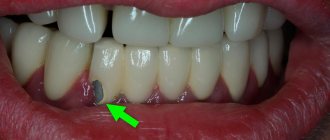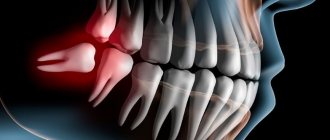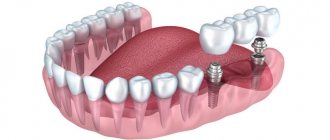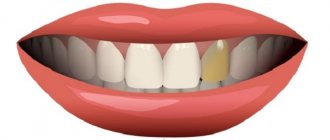Many patients ask dentists: should teeth be a little loose or does this indicate some kind of disease? Some mobility of dental units is observed normally, but it is very small and usually not noticeable. If a person’s teeth are noticeably loose and we are not talking about milk teeth, which should soon be replaced, it is necessary to find the cause of their mobility and eliminate it. Why do teeth become loose in adults, how to treat this pathology and what should be done in this case?
Symptoms
In the vast majority of cases, teeth become loose due to advanced caries and the presence of tartar. Clear signs that you will experience periodontal problems in the coming months:
- dark spots on tooth enamel;
- bleeding gums;
- high sensitivity of teeth to cold/hot;
- pain when chewing.
At the initial stage, the amplitude of tooth loosening does not exceed 1 mm. Subsequently, it increases, and the tooth wobbles in all directions. Biting or chewing with it is uncomfortable or even impossible.
Periodontal diseases are most often accompanied by atrophy of the jaw bone. That is, the volume of bone tissue in which the teeth are anchored gradually decreases. This is clearly noticeable by the “sagging” of the gum line, the formation of gum pockets and the increasing exposure of the necks of the teeth. If no measures are taken, bone volume can decrease catastrophically, leading to loose teeth. And this already threatens their loss.
Implant mobility due to patient negligence
The main reason why the intraosseous structural element began to wobble is ignoring the recommendations regarding the care of implants and the orthopedic system fixed to them. If the surgeon performed the implantation without violating the protocol, 90% of the responsibility for rehabilitation lies with the patient. The following can lead to loosening of the structure:
- Refusal of medications prescribed by the surgeon for the speedy restoration of injured tissue, prevention of the inflammatory process, etc.
- Regular consumption of alcohol and smoking slow down the rate of engraftment of the artificial root, increases the risk of peri-implantitis, and impairs blood circulation in the tissues. Clinical studies have shown that implant failure in patients with bad habits is 3 times higher than in those who do not have them.
- Overload of the artificial root when chewing hard foods. Premature chewing load on the implant. Typically, the doctor recommends following a soft diet for 2-3 weeks after the intervention. Ignoring the recommendation leads to displacement of the implant in its bed, disruption of osseointegration and, as a consequence, rejection of the intraosseous element.
The survival rate of a titanium structure is also affected by systemic diseases accompanied by impaired regenerative processes. These include diabetes mellitus, immunodeficiency states, oncological processes, some pathologies of the central nervous system, and chronic processes in the oral cavity.
Teeth started to loosen: what to do?
The sooner you go to the dentist, the greater the chance of saving the tooth. The doctor will suggest taking a targeted or panoramic X-ray, depending on how many teeth are loose. They can be used to determine the degree of periodontal damage and bone loss.
Before starting treatment, it is necessary to carry out professional oral hygiene - clean the teeth (including under the gums) from hard deposits (tartar) and bacterial plaque. This is a standard procedure performed with an ultrasound machine. Ideally, such cleaning should be carried out once every six months.
If necessary, the patient also undergoes systemic diagnostics and consults with specialized doctors. Further treatment depends on how loose the teeth are and what the causes of the loosening are.
Professional ways to strengthen tooth enamel
Depending on the condition of the enamel and oral cavity, the dentist may offer one or another method of restoring the enamel:
- fluoridation. This method involves applying a complex of mineral components including calcium and fluoride to the surface of the teeth, which saturates the enamel with mineral elements, strengthening its protective functions. The advantages of fluoridation include the complete safety of the method (if it is carried out under the supervision of a specialist, since a lack of fluoride is no less dangerous than its excess), therefore this procedure is often prescribed to young patients - to protect baby teeth;
- installation of veneers Veneers, a thin plate glued to the front side of the tooth, are an ideal choice if you are concerned about chips and cracks in the enamel, if you suffer from excessive tooth sensitivity, if the enamel has almost worn off. In addition, veneers are often installed when it is necessary to correct the shape, size or color of teeth. With careful handling, a veneer can serve its owner flawlessly for many years;
- installing a filling on the damaged area. Filling not only strengthens the enamel, but also restores the anatomical shape of the tooth. In addition, this method eliminates the problem of increased tooth sensitivity. Modern fillings are made from high-quality composite compounds that are completely safe for human health and have a long service life - under favorable conditions, a high-quality filling can serve you for more than ten years;
- the use of mineral infiltrate is the best that modern dentistry can offer when it comes to the regeneration of tooth enamel. The doctor applies a mixture to the surface of the teeth that contains a special mineral-containing material - this material penetrates the enamel structure, hardens there, stopping the source of inflammation. As in the case of fluoridation of teeth, the use of mineral infiltrate is aimed at restoring and strengthening the enamel through its artificial enrichment with minerals
Taking care of the health of tooth enamel is the minimum that will allow you to avoid a huge number of problems with the oral cavity in the future, ranging from the development of caries, pulpitis and ending with increased sensitivity of the teeth.
What will the doctor do if the tooth is loose?
In modern dentistry, tooth-preserving methods are practiced, so a tooth is removed only if it is very loose and cannot be restored. When an adult’s teeth become loose, treatment depends on the causes and course of the pathological process.
If the loosening is still minor and is caused by weakening of the gums, it is necessary to clean the periodontal pockets from bacterial deposits. For this purpose, therapy is carried out using the Vector device. The doctor directs a healing mixture into the pockets, which acts simultaneously with ultrasonic vibrations and effectively cleanses the teeth down to the roots. The procedure is painless and promotes gum healing. Also, many dentists use lasers for the same purposes.
After this, the doctor prescribes therapeutic treatment:
- applications with antiseptic drugs;
- applying medicinal gels to the gums that relieve inflammation and restore tissue;
- strengthening gums with rinses - herbal infusions (aloe, oak bark);
- taking vitamins;
- gum massage, which needs to be performed 3-4 times a day on your own;
- if there is inflammation with purulent discharge, the dentist will recommend antibiotics.
In severe cases of periodontitis, when the gum pockets are deep (more than 7 mm), surgical intervention may be necessary - open curettage. During this procedure, the surgeon opens the gum, clears the pocket of infection, applies medication, and sutures the tissue.
Loosening of the cement connection between the crown and the abutment
The prosthetic structure can be fixed on the abutment using dental cement. Sometimes, under the influence of external factors, its composition changes over time. As a result, the cement is destroyed, washed out, and the person notices that the crown on the implant is loose. This may be caused by frequent chewing of very hard foods or eating too hot or cold foods. With cement fixation, it is difficult to remove the crown without damage, so it may need to be replaced. But this option is also possible: the prosthesis is removed, freed from cement residues and installed in place using a new fixing mass.
What to do if the tooth is very loose?
An effective method of strengthening teeth is splinting. It returns teeth to their functions and allows you to avoid extraction for a long time. Tires are most often made from safe fiberglass material; aramid threads, metal and ceramics can be used. The purpose of the procedure is to fasten the mobile teeth between themselves and the adjacent healthy teeth.
The splint is installed on the inside of the dentition by drilling shallow grooves in the teeth. Fiberglass tape or aramid cord is secured into these grooves with dental adhesive, and then they are filled and polished. Durable and aesthetic materials prevent teeth from loosening further, and therapeutic methods help strengthen periodontal and gum tissue. In many cases, it is possible to significantly reduce the degree of mobility.
Violation of the screw connection between the prosthesis and the implant
When a patient complains about the mobility of the prosthetic structure, the specialist first checks the stability of the supporting implant. If there are no problems with the root substitute and the bone tissue around it is quite dense, the problem may lie in the fixation screw. This is a fastening element that connects the prosthesis to the supporting part of the system. Often this is the reason why the crown on the implant has become loose. For example:
- The screw came loose. In this case, the dentist drills a hole in the crown to gain access to the retainer to re-tighten it.
- The screw broke. In such a situation, it has to be removed, then the structure must be secured with a new fixing element.
- Food debris got into the implant shaft. The screw is cleaned and replaced if there is no other damage.
Prevention
The best prevention of tooth mobility is good oral hygiene. To do this, the doctor will recommend special products and instruments: paste, balm, rinse, dental floss, irrigator. Regular (once every 6 months, and in case of gum problems - once every 3-4 months) visits to the dentist for professional teeth cleaning are required. You should also pay attention to proper nutrition, rich in calcium, vitamins and minerals.
Publisher: Expert magazine about dentistry Startsmile.ru
Author of the material: Igor Skripnik
Prevention of crown loosening on an implant
It is easier to prevent any pathology than to eliminate it. To maximize the service life of the crown-abutment-implant system, the following preventive rules should be followed:
- Don't neglect oral hygiene. Brush your teeth twice a day, use irrigators to wash out food debris from hard-to-reach places.
- Do not overload artificial teeth by chewing too hard food, do not crack nuts, do not chew crackers.
- Try to give up bad habits.
In addition, you can prevent or detect the problem in time if you visit the dentist every six months to examine the implantation area and check the condition of your own and artificial teeth.
What determines the strength of a crown?
Most often, crowns become loose after poor quality treatment. Many people turn to unverified clinics because they offer prosthetics at very low prices. However, often after such procedures you have to look for a good doctor to correct the mistakes of a less experienced specialist.
When undergoing prosthetics, it is important to pay special attention to preparing the tooth for the installation of a crown. The reliability of fixation of the orthopedic structure depends on:
- from the shape of the stump tab or pin,
- height of location and taper of the base,
- thickness of fabrics for sanding,
- forms of the gingival ledge.
When preparing a tooth, sufficient water cooling is necessary. It is recommended to install crowns on living tissue, since dead tissue is fragile, which shortens the service life of the structure.
What can you do at home?
If you are unable to get an appointment with a specialist in the near future, before visiting the doctor you should ensure the maximum level of hygiene and also treat the problem tooth with care. As optimal antiseptic measures, rinsing with Chlorhexidine or Miramistin, tincture of propolis or calendula is recommended, especially if there are signs of an inflammatory process. Among traditional medicine, chamomile, sage, oak bark, and soda-salt solution have proven themselves to be quite good.
Chamomile decoction helps well in treatment
Causes of loose teeth
Remember: it is very difficult to independently determine the true cause of loose molars in an adult. Diagnosis of pathology should be carried out exclusively by the dentist.
The most common causes of loose teeth are:
- various gum diseases;
- periodontitis or periodontal disease;
- scurvy;
- lack of calcium in the body;
- avitaminosis;
- osteoporosis;
- lack of blood supply in the gums;
- oral candidiasis.
Often in adults, teeth begin to become loose due to exacerbation of chronic diseases. For example, psoriasis, thyroid disease, diabetes, heart disease, and late stages of arthritis can lead to loose teeth.
Mechanical injuries, from minor bruises to significant fractures, can lead to loose teeth and tooth loss. Even if the injury seems minor to you, do not be lazy to consult a doctor and undergo an orthopantomogram.
While waiting for a baby, many women experience increased loosening of their teeth. During pregnancy, a woman must take special vitamins and supplements.
During this special period, the female body lacks calcium, vitamins and microelements. The baby in the womb grows quickly, which leads to the depletion of the woman’s immunity. The composition of saliva changes, which provokes the destruction of enamel and precariousness of the dentition.
Gum massage
Regular gum massage will help improve blood flow in the jaw and avoid the development of inflammation in the future. You can do massage yourself, even if you are far from medicine.
- First, wash your hands thoroughly.
- Then move your thumb and index finger along the gums: using circular movements, you need to massage the gums from the central part to the sides.
- Massage your gums for 5 minutes.
- Repeat the procedure morning and evening.
It is recommended to end each massage session with a herbal rinse, for example, a decoction of chamomile or oak bark.
A tooth deteriorates under a crown: truth or myth?
Any type of prosthetics is a complex dental procedure, after which complications may arise. However, if you lose one or even several teeth, installing implants is the most correct treatment option. If after prosthetics the tooth under the crown begins to hurt, this may be either normal or a deviation from the norm. In both cases, professional advice is required.
Where is the problem?
It is not uncommon for patients to deliberately refuse prosthetics. This is due to the unsuccessful experiences of themselves, relatives or friends. It should be understood that if a tooth is lost, such an intervention is correct for the body. It allows you to restore the functionality of the tooth. If all procedures are performed correctly, the patient strictly follows the rules of hygiene, dental crowns will last him a long time. But this process is associated with a number of errors and inaccuracies, which can subsequently lead to damage to the tooth and replacement of the implant.
There are four important aspects to this problem:
- errors at the preparation stage;
- poor dental work;
- low-quality materials;
- incorrect hygienic care.
Clinical symptoms
The very first signs of problems with the dental crown will be pain, bleeding, and possibly purulent discharge. The patient may also be concerned about:
- decreased tooth fixation - the crown is loose and does not fit tightly to the gum;
- redness, swelling of the gums and adjacent tissues;
- increased sensitivity;
- unpleasant putrid odor from the mouth;
- itching, irritation;
- the appearance of excess plaque.
Photo 1. Inflammation of the gums under the crown
| Cause | Symptom |
| Pulp inflammation | Sharp cutting pain that occurs in the evening or at night. |
| Caries | Increased sensitivity to hot and cold foods. An unpleasant odor appears from the mouth. Pain occurs when chewing. |
| Periodontitis | Unpleasant sensations in the neck of the tooth. Signs of inflammation are observed: swelling and redness. |
| Incorrect crown installation | The crown rubs, puts pressure on soft tissues, does not fit firmly to the gums and wobbles. The pain is dull, aching, and does not go away for a long time. |
Table 1. – Comparative characteristics of the localization of pain and the causes of its occurrence
There was pain
The appearance of pain signals the patient about the development of inflammation in the oral cavity. When installing the crown itself, tissues are injured. Usually, such microtraumas heal quickly and pain does not appear at all. But if a person initially had a decrease in immunity, then microorganisms actively multiply and cause inflammation.
Pain can also develop due to an allergic reaction to the filling material.
Attention: before installing an implant, you must consult a dentist and an allergist about the possible development of allergic reactions to the materials from which dental crowns are made and impressions are made.
Pain also appears in case of exacerbation of hidden pathology, since trauma to tooth tissue during the procedure and a change in load distribution induces the process of inflammation. As a result, pain appears.
If there is pain under the crown, you should immediately contact your dentist. He will prescribe the correct treatment, which can be either therapeutic or surgical. In some cases it will be necessary to remove the crown, while in others it will not be necessary.
It is also possible to make a hole, clean and re-seal the canals. The crown is then covered with dental material, and its function is considered restored.
It is possible to perform surgery to remove the root tip. This procedure is usually performed in the presence of a purulent sac. The poorly sealed apex is removed, the dentist reaches the purulent sac, cuts the gum tissue, removes it, treats it with an aseptic agent and the edges of the gum are sutured.
Photo 2. Removing the root tip
And the last case of pathology, when it is necessary to remove the crown and refill the canals, is an advanced and deep inflammatory process. Although in serious situations, dentists usually remove the crown and tooth, after which a post with a dental crown is installed.
Causes of pain under the crown
Only a dentist can determine the exact cause of pain under the crown. However, the most common ones are:
- the root canals are not filled correctly (an inflammatory focus or even a cyst forms at the root of the tooth);
- poor obturation of root canals (can lead to various complications:
- Immediate: Longitudinal root fracture, post-filling pain, exacerbation of a chronic inflammatory process;
- Long-term consequences: the emergence of a focus of chronic odontogenic infection, the focus of infection persists or progresses, change in the color of the tooth crown;
- perforation of the walls of the root canal (may appear as a result of caries or after mechanical trauma to the tooth; the most common reason is bending of the canals, which significantly complicates tooth treatment);
- breakage of an instrument in the lumen of the root canal (a dangerous situation for the dentist and the patient, the outcome of which depends on many factors, including the material of the crown, the location and size of the instrument, and the anatomical features of the root canal).
Less commonly, they can also cause pain:
- rubbing gums;
- periodontitis;
- insufficient tooth depulpation before prosthetics;
- root damage from incomplete preliminary preparation;
- installation of an implant on diseased teeth;
- root canal infection;
- excessive filling of the root canal with filling material;
- wear of the prosthesis.
Attention: if pain appears immediately after installation of the prosthesis or during the first week, this indicates improper preparation of the tooth, and the patient should immediately contact the dental clinic.
How to get rid of pain
Every patient should understand that the use of painkillers and other options for pain relief are just symptomatic treatment that will not solve the problem. At the first manifestation of pain, you should immediately consult a doctor. Ways to relieve toothache include:
- Painkillers, for example, Diclofenac, Ketorolac, Nimesil, Tempalgin, Ibuprofen (dosage forms - tablets, gel).
- Applying a cold salt compress to the damaged gum.
- Mouth rinse. To do this, use a decoction of herbs such as sage, calendula or chamomile, as well as a soda solution.
- Rinse with baking soda and iodine. In addition to eliminating pain, such rinsing will relieve itching and irritation.
- Compress with valerian and camphor. This folk remedy will help in the fight against pathogenic microorganisms and soothe inflamed gums.
Attention: do not abuse painkillers. They should be carefully alternated with rinses. It is not recommended to take pills before visiting a doctor to avoid distorting the symptomatic picture.
Prevention
To prevent complications after installing a crown, it is important to regularly visit the dentist for a preventive examination (1-2 times a year at least; if discomfort occurs, immediately seek advice). You should strictly observe the rules of oral hygiene every day. Cleaning products must match the material from which the prosthesis is made. Dentists recommend using additional elements for cleaning teeth: special brushes, brushes, dental floss, and irrigator.
You must strictly follow all recommendations of your treating dentist. You should give up bad habits such as alcohol and smoking, because they have a bad effect on the mucous membranes and induce the development of the inflammatory process. If the patient cannot completely quit smoking, then the harmful effects of nicotine and other substances should be minimized. To do this, after smoking a cigarette, you should immediately brush your teeth and rinse your mouth with a special product.
How to care for a crown
General methods of crown care are given in the table.
| Toothbrush | Mostly medium hard. Cleansing movements are directed from the gums to the cutting edge of the tooth. Use at least 2 times a day (more if necessary, but the risk of injury to the prosthesis may increase). The toothbrush must be replaced every 3 months. Attention: to clean hard-to-reach places, you can purchase a mono-tuft brush). |
| Toothpaste | Preference should be given to medicinal pastes that strengthen the gums and reduce bleeding. They usually contain herbs. It is forbidden to use pastes containing abrasive materials, as they damage the crown. |
| Dental floss | It is worth choosing “super floss”, designed specifically for dentures. They clean the surface of the prosthesis from the gum side as well as possible. Caution: Regular floss is too harsh for a dental crown and can damage it. |
| Irrigator | A professional product that uses a jet of water under pressure to remove plaque, pathogenic microorganisms and food debris. The nose of the irrigator should be directed towards the area between the denture and the gum. The pressure of the supplied water should initially be minimal, and then it should be gradually increased to average values. Attention: in addition to the high cleaning coefficient, the irrigator massages the gum tissue, thereby improving blood circulation. |
| Rinse aid | Selected in accordance with the dentist's recommendations. It should have antibacterial properties and should not spoil the crown materials. |
Table 2. – Cleansers recommended for use when installing dentures.
Some care features determined by the material of the manufactured crown are given below.
Crowns on implants
Once the structure has completely fused with the tissue, you can return to a full life. There will be no special dietary restrictions here, except for a ban on very hard foods, cold and hot. Chew your food thoroughly and slowly, cutting hard foods into smaller pieces.
Metal-ceramic crowns and bridges
Metal is the most durable material, but still you should not use improvised means to clean the implant, as they can damage the coating of the crown and the enamel of other teeth.
Attention: Under no circumstances should you try to open nuts, bottles or other objects with your teeth!
Metal-free zirconium crowns and bridges
Caring for prostheses made from such materials should be more thorough and gentle. It is recommended to use a special mini-brush, which carefully and thoroughly cleans hard-to-reach places
Restoration of the coronal part of the tooth using modern light-curing composites
Tooth restoration is a procedure that is performed for cosmetic tooth defects. It allows you to improve a tooth damaged by caries, restore broken ones, straighten teeth, and correct color. Composite systems have high ductility and strength, they exactly match the characteristics of the dentition.
The procedure can be carried out in two ways:
- Direct (composite materials are applied directly to the tooth).
Photo 3. Direct tooth restoration
- Indirect (restoration elements are pre-fabricated).
Photo 4. Indirect tooth restoration
With conventional prosthetics, the main goal is to restore the functioning of the tooth, and with their restoration - the aesthetic side. To add shine and natural color, dentists use photocomposites, which are applied to the teeth in layers using adhesives.
When to see a doctor
The appearance of pain after installation of a prosthesis may be a normal condition that will soon go away. Dentists recommend that patients listen to their feelings: if the condition is unsatisfactory, then a trip to the doctor will definitely not be superfluous. You should not endure and hope that the pain will go away, because the process may worsen, and then the doctor will have no choice but to remove the tooth and install a new prosthesis.











